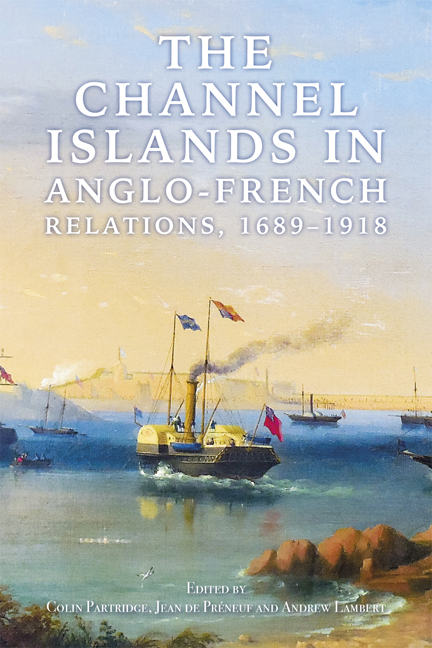Book contents
- Frontmatter
- Dedication
- Contents
- List of Illustrations
- List of Contributors
- Preface
- Introduction: ‘The Ehrenbreitstein of the English Channel’
- Part 1 Corsairs – the Ancien Régime and French Wars from 1689
- Part 2 The Islands – French and British Intelligence from the Seven Years War to 1815
- Part 3 Territorial Waters – the Land and Sea Interface from the 17th to 20th Centuries
- Part 4 Engineering Strategic Change
- Part 5 Alderney and the Channel Islands – Naval Strategy from 1815 to 1905
- Part 6 Civil Societies and Anglo-French Naval Rivalry – the 19th Century to WWI
- Part 7 Trade War – the Protection of Channel Islands Shipping in the Great War
- Afterword: Alderney, The Channel Islands, and the Study of History
- Bibliography
- Index
7 - The Channel Islands in French Naval Strategy from 1815 to 1906
Published online by Cambridge University Press: 15 May 2024
- Frontmatter
- Dedication
- Contents
- List of Illustrations
- List of Contributors
- Preface
- Introduction: ‘The Ehrenbreitstein of the English Channel’
- Part 1 Corsairs – the Ancien Régime and French Wars from 1689
- Part 2 The Islands – French and British Intelligence from the Seven Years War to 1815
- Part 3 Territorial Waters – the Land and Sea Interface from the 17th to 20th Centuries
- Part 4 Engineering Strategic Change
- Part 5 Alderney and the Channel Islands – Naval Strategy from 1815 to 1905
- Part 6 Civil Societies and Anglo-French Naval Rivalry – the 19th Century to WWI
- Part 7 Trade War – the Protection of Channel Islands Shipping in the Great War
- Afterword: Alderney, The Channel Islands, and the Study of History
- Bibliography
- Index
Summary
Within French naval strategy between 1815 and 1906, the Channel Islands were part of France's global rivalry with London. Several elements of this strategy and the interactions between them merit consideration. France is an amphibious nation. Both continental and maritime, it has faced numerous landand sea-based threats, from both within Europe and overseas. The country is surrounded by sea on three sides and also has to deal with the lock that is Gibraltar. The unifications of both Italy and Germany, followed by the signing of the Triple Alliance, increased the complexity of this geostrategic challenge. France's strategy involved prioritising and identifying links among the threats posed by Germany, Britain and Italy. It was only Italy's neutrality and then the Entente Cordiale that would change matters in the early twentieth century.
This complexity could be seen in the English Channel when it came to selecting a main naval base within it. While siting the base at Dunkirk would have made it possible to block the Hochseeflotte (hereafter HSF)'s entry into the Channel from the north, as well as posing a threat to London, the port was isolated and exposed. At the western end, Brest was well protected, but it was far not only from France's industrial base but also from the British centre of gravity and the Dover Strait. Meanwhile, Cherbourg, right in the middle of the Channel, was isolated from Paris until the mid-nineteenth century and vulnerable to the Royal Navy and the HSF. This vulnerability was increased by the development of Portland and Alderney. The narrowness of the central section of the Channel meant that fluidity was limited: British bases were close, navigation difficult and the legal framework restrictive. The configuration of the waters and the coastline favoured denial of access and raids on commerce or bases. This combination of limiting factors was reinforced by the technological revolutions that came along after 1850. The debate, which mainly concerned coastal protection and commerce raiding, was arbitrated by civil society because naval policy partly escaped experts’ control owing to statements made in parliament and the press. Many actors therefore contributed to the development of naval strategy.
- Type
- Chapter
- Information
- The Channel Islands in Anglo-French Relations, 1689-1918 , pp. 131 - 147Publisher: Boydell & BrewerPrint publication year: 2024



